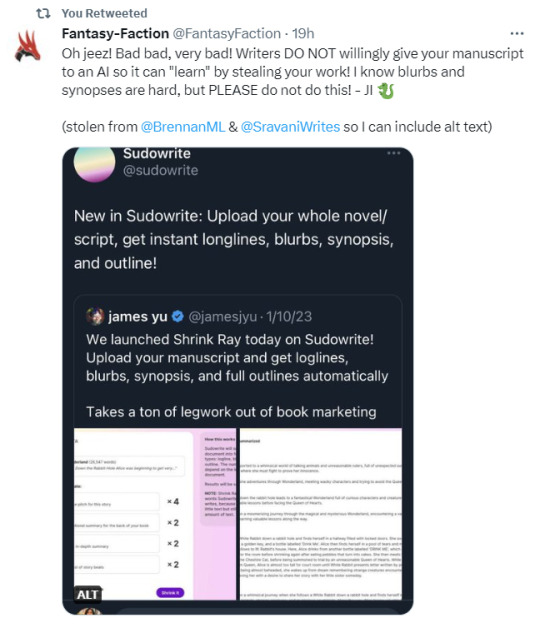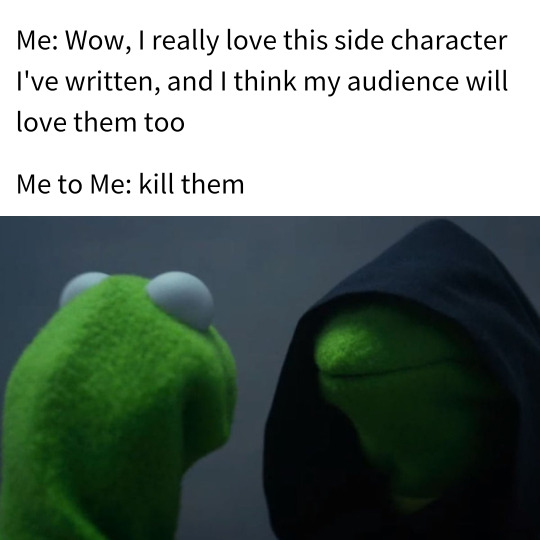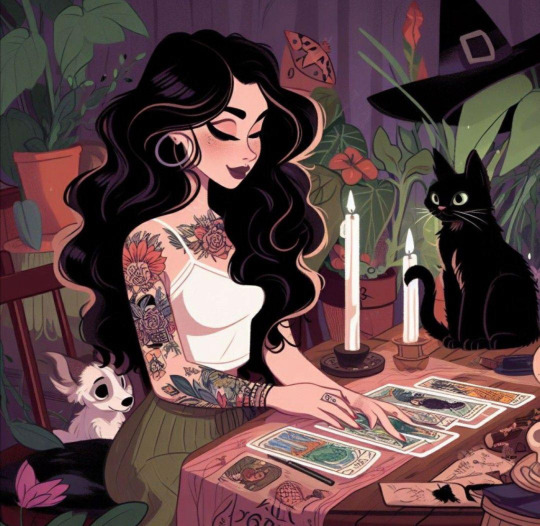#author life
Text

#writing#writing memes#writing life#writing community#author memes#writers on tumblr#author life#writeblr#writers#meme#veryrealauthorthings#authorblr#on fanfiction#fanfic writers#i love my fans#a03 writer#writing wins
23 notes
·
View notes
Text
writing tip #3255: the fewer the fucks given, the better the writing. get out of your head and onto the page.
#writeblr#writers#creative writing#original writing#writeblr community#writing#jgmartin#writers of tumblr#authors supporting authors#writing advice#tips#literature#author life#indie author
1K notes
·
View notes
Text

GUYS DO NOT GIVE YOUR MANUSCRIPT TO AN AI THIS IS A BAD IDEA ON EVERY LEVEL DON'T DO IT
original tweet from @jamesjyu reads: "We launch Shrink Ray today on Sudowrite! Upload your manuscript and get loglines, blurbs, synopsis, and full outlines automatically. Takes a ton of legwork out of book marketing. Below the tweet are two images of the program."
original quote tweet from @sudowrite reads: "New in Sudowrite: Upload your whole novel/script, get instant longlines (sic), blurbs, synopsis, and outline!"
tweet from @FantasyFaction reads: "Oh jeez! Bad bad, very bad! Writers DO NOT willingly give your manuscript to an AI so it can "learn" by stealing your work! I know blurbs and synopses are hard, but PLEASE do not do this! - JI 🐉
(stolen from ML Brennan & Sravani Hotha so I can include alt text)"
#ai writing#ai theft#ai generated#writing advice#writers block#fantasy-faction#fantasy#fantasy books#reading#booklr#books and libraries#bookblr#book blog#self publishing#self published#author life#fanfic writing#fanfiction#writing#writers#writers on tumblr#writer community#writer challenge#female writers#writer problems#writblr
3K notes
·
View notes
Text

#writing memes#writers block#writeblr#writers on tumblr#writing#author woes#writer woes#writer problems#writer life#author problems#author life#ao3 author#ficcin' be like#fanfic writing#writing problems#writing woes#fic writing#fanfic woes#fanfic meme#ao3 memes#author meme#writers of tumblr#writers#writer#writers on ao3#ao3 writer#fic life#writing life#writer's life#writer's block
1K notes
·
View notes
Text

I am a writing genius who totally planned this
#writers on tumblr#writing fantasy#writer problems#writer#writing#writeblr#writing meme#author life#author problems#author meme#authors#author#book#books#wip#novel#fantasy#fiction book#fantasy fiction#writing fiction#fiction#meme#kronk#kronk meme
3K notes
·
View notes
Text

#writing#author#meme monday#writers#writerslife#writing memes#author meme#writer memes#writer problems#wip#author life#author problems#evil kermit#character death
364 notes
·
View notes
Text
Fear: Using Stoicism to Shape Characters

WC: 2,730
Introduction
Like many people, I suffer from severe panic and anxiety attacks. My heart races at what feels like a thousand beats per minute, I get a cold sweat, and my thoughts do not have a filter. The latter of which, I find the most dangerous and disturbing, especially when said attacks get triggered by something so small or nothing at all.
A lot of the time, they boil down to not feeling safe. I feel like I’m vulnerable, that the worst things that happened to me will happen again tenfold, or I’ve become the worst person in existence. Fear, as a lot of us know, can have us assume the worst.
I’m still working on managing my fear, if it can be managed at all, but a lot of what I’ve been practicing is essentially Stoicism. Epictetus, a Greek Stoic philosopher, often highlighted that it is not events themselves that disturb people, but rather their judgments about those events. One famous quote attributed to Epictetus that reflects this idea is: “People are not disturbed by things, but by the view they take of them.”
This sentiment suggests that fear and other negative emotions stem not from objective reality but from our interpretations and perceptions of reality.
I thought, “What a wonderful way to get to know our characters!” Not only do we have to have a grasp on the world around them, we have to understand the extent of how they perceive said reality and how it leads to their own fears as well as their ambitions, passions, hate, love, etc.
Amor Fati
One of my favorite phrases is “amor fati.” It’s what helped me most in navigating my own fears and, as a result, writing some ways in which my characters handle theirs.
The idea of “amor fati” is closely associated with philosophers like Epictetus and Marcus Aurelius, even though they didn't use those exact words. However, it was Nietzsche who made it a key part of his philosophy. He believed that true greatness comes from embracing fate and wanting nothing to change, not in the past, present, or future. In simple terms, it means loving and accepting everything that happens, rather than just enduring it.
When considering the relationship between “amor fati” and fear, several key points emerge:
Acceptance of the Uncontrollable: Fear often arises from the unknown or from circumstances beyond our control. “Amor fati” encourages individuals to relinquish their resistance to such uncertainties and to accept that life is inherently unpredictable. By embracing fate, individuals can find solace in the realization that some things are simply beyond their power to change or influence.
Facing Adversity with Resilience: Rather than viewing challenges as threats to be avoided or overcome, individuals can approach them with a sense of equanimity and resilience. Instead of succumbing to fear or anxiety in the face of challenges, one can choose to see them as opportunities for growth and self-discovery. By embracing adversity as an integral part of life’s journey, individuals can cultivate the strength and fortitude necessary to navigate difficult times with grace and composure.
Gratitude for All Experiences: Fear often stems from a sense of insecurity or dissatisfaction with one’s circumstances. “Amor fati” cultivates gratitude for all experiences, both positive and negative, recognizing that each contributes to the richness and depth of life. By embracing fate with gratitude and appreciation, individuals can mitigate the fear of the unknown and find peace and contentment in the present moment.
This idea is what helps form a “baseline” for my way of thinking and perceiving fear, which is what many people, fictional characters included, tend to mix up.
You don’t need to adopt the same mantra, of course, but I believe that having this Ground 0 in your own personal philosophy will add further depth and characterization in writing. It provides a deeper perspective on why your characters think the same or why they may deviate.
Distinction Between Events and Perceptions
Let’s go back to what Epictetus said: “People are not disturbed by things, but by the view they take of them.” Stoicism teaches that events themselves are neutral; it is our interpretation of those events that shapes our emotional responses. This concept is often referred to as “cognitive appraisal” or “judgment” in Stoic philosophy.
In practical terms, this means that two individuals may encounter the same external circumstance, yet react to it in vastly different ways based on their subjective interpretations. For example, consider a person who loses their job unexpectedly. While one individual may perceive this event as a devastating blow to their self-worth and security, another may view it as an opportunity for growth and new possibilities. The event itself—the loss of a job—remains the same, but the emotional response varies depending on the individual's perception of the situation.
Epictetus’s insight invites us to reflect on the role of our perceptions in shaping our emotional experiences. It suggests that our judgments, beliefs, and attitudes about the events we encounter play a crucial role in determining how we feel and behave in response to those events. By recognizing this distinction between events and perceptions, individuals can gain greater agency over their emotional lives.
Moreover, understanding this distinction empowers individuals to practice what Epictetus called the “dichotomy of control”—the Stoic principle of focusing only on what is within our power to control, namely our thoughts, attitudes, and responses, rather than becoming consumed by external circumstances beyond our control. By directing our attention inward and cultivating a mindset of resilience and rationality, we can navigate life's challenges with greater equanimity and inner peace.
Applying this to character development, particularly in relation to crafting a character’s fears, can add depth and complexity to the character.
Understanding the Character’s Perception of Fearful Events:
Explore how the character interprets and perceives the events or situations that evoke fear. What underlying beliefs, past experiences, or personal values shape their perception of these events?
Consider whether the character’s fear is rooted in the objective reality of the situation or in their subjective interpretation of it. For example, is their fear based on genuine physical danger, or is it driven by irrational beliefs or past traumas?
Revealing Character Traits and Beliefs:
A character’s response to fear can provide insight into their personality, values, and beliefs. For instance, do they confront their fears head-on with courage and resilience, or do they succumb to anxiety and avoidance?
Consider how the character’s fear reflects broader themes or conflicts in the story. For example, does their fear stem from a desire for control, a fear of vulnerability, or a struggle with existential questions?
External Manifestations of Fear:
Consider how the character’s perception of fear manifests in their actions, behaviors, and interactions with others. Do they exhibit outward signs of fear, such as trembling or avoidance, or do they mask their fears behind a facade of bravado?
Pay attention to how the character’s response to fear influences their relationships with other characters. For example, do they push others away in an attempt to protect themselves, or do they seek support and connection during times of fear and uncertainty?
Symbolism and Subtext:
Use the character’s fears as a vehicle for exploring deeper themes and subtext within the story. What do their fears symbolize in terms of larger narrative themes or character arcs?
Consider how the character’s perception of fear parallels or contrasts with other characters in the story, providing opportunities for reflection and exploration of different perspectives.
“Personal Truths” Are Not Necessarily Lawful
No matter how much a character is afraid of something, there is a line to be drawn on how valid that fear is when justifying a character’s actions and self-proclaimed motives. A person can say that they are afraid of someone else and that they are acting to protect others, but does that truly evade them from the law? In other words, a Villain can be completely convinced that what they are doing is noble and right, or that it stems from their own trauma, but, at the end of the day, they’re a murderous liar.
For example, in George Orwell's allegorical novel Animal Farm, Napoleon is a Berkshire boar who emerges as one of the leaders of the animal revolution against the human farmer, Mr. Jones. Initially, Napoleon is portrayed as a strategic thinker and persuasive speaker, working alongside Snowball, another pig, to rally the other animals and establish the principles of Animalism, which advocate for equality and freedom from human oppression.
As the story progresses, Napoleon’s character undergoes a transformation fueled by his ambitions for power and control.
Napoleon’s fear of losing control over the farm drives many of his actions. He becomes increasingly paranoid about potential threats to his authority, particularly from Snowball, whom he views as a rival. This fear prompts him to manipulate and eliminate anyone who opposes him, including orchestrating the expulsion of Snowball from the farm and later falsely accusing him of being a traitor.
He also utilizes propaganda and manipulation to maintain his grip on power. He gradually assumes control over the farm’s decision-making processes, consolidating power in his own hands and using fear tactics to suppress dissent among the other animals. For example, he employs the threat of the mysterious “Jones” returning to instill fear and obedience among the animals.
Napoleon’s lust for power leads him to betray the principles of Animalism that he once espoused. He progressively becomes more authoritarian and exploitative, engaging in corrupt practices such as trading with humans and altering the Seven Commandments to justify his actions. Despite initially advocating for equality, Napoleon begins to live a life of luxury while the other animals toil and suffer.
As his regime becomes more entrenched, he resorts to violence and oppression to maintain control. He establishes a reign of terror, using his loyal enforcers, the ferocious dogs he raised since they were puppies, to suppress dissent and punish any animal perceived as disloyal. Under his rule, the farm descends into a state of fear and tyranny, with Napoleon ruling with an iron fist.
Napoleon’s character serves as a symbol of totalitarianism and the corrupting influence of power. His transformation from a revolutionary leader to a despotic dictator mirrors the rise of real-life totalitarian rulers who exploit fear and propaganda to consolidate power and suppress dissent. There is not one moment of self-reflection, of him questioning that, perhaps, his fears are unfounded or his “personal truths” are not true at all.
Playing With Reality
Now, how can you utilize fear in order to create a character with as much depth and reflection (or lack thereof) like Napoleon?
Exaggerating a character’s fear involves manipulating elements of reality within the narrative to heighten the character’s sense of paranoia, insecurity, and authoritarianism.
Distorted Perceptions: Employ literary devices such as unreliable narration or distorted perspectives to amplify the character’s fears. By presenting events through the lens of the character’s paranoia, the narrative can create a sense of heightened tension and uncertainty. For example, descriptions of seemingly innocuous occurrences may be exaggerated or imbued with sinister undertones to reflect the character’s heightened state of fear.
Symbolism and Imagery: Symbolic imagery can be used to represent the character’s fears in a heightened and exaggerated manner. For instance, recurring symbols of oppression, surveillance, or impending doom can serve as visual metaphors for the character’s anxieties and insecurities. These symbols can be woven throughout the narrative to reinforce the character’s sense of paranoia and isolation.
Surreal Elements: Introducing surreal or fantastical elements into the narrative can create a sense of disorientation and unease, effectively amplifying the character's fear. By blurring the boundaries between reality and fantasy, the author can evoke a sense of psychological instability and existential dread. Surreal imagery, dream sequences, or hallucinatory experiences can all contribute to the character’s sense of dislocation and terror.
Manipulation of Time and Space: Playing with the conventions of time and space can further exaggerate the character’s fear and disorientation. Flashbacks, flash-forwards, or nonlinear storytelling techniques can create a sense of temporal dislocation, mirroring the character’s fractured mental state. Similarly, disorienting shifts in perspective or setting can contribute to the character's sense of being trapped or pursued by unseen forces.
Atmospheric Detailing: Careful attention to atmospheric detail can help to create a sense of oppressive dread and foreboding. Descriptions of the environment—such as gloomy weather, claustrophobic settings, or unsettling ambient sounds—can evoke a palpable sense of unease, intensifying the character's fear and paranoia.
Character Interaction and Dialogue: Dialogue and interaction with other characters can be used to reinforce the character’s fears and insecurities. Conversations may be laced with veiled threats, double entendres, or gaslighting tactics, leaving the character uncertain of whom to trust. Manipulative or menacing exchanges can heighten the character's sense of isolation and vulnerability.
Did anyone else get a little uneasy imagining all of that? I’d go rather mad if I had all of that happening to me, too. Now, what about the good guys? They are afraid of things, too, right?
Of course they are, and you can utilize the above methods for your heroes, as well! There might just be a little bit of extra work involved in ensuring that they don’t spiral into the villain role.
Establish Strong Moral Compass: From the outset, establish the hero’s core values and moral compass. Make it clear what principles guide their actions and decisions. This foundation will serve as a guiding light, helping to anchor the character and prevent them from straying into villainous territory.
Empathy and Compassion: Ensure that the hero retains their empathy and compassion towards others, even in the face of fear and adversity. By prioritizing the well-being of others and demonstrating empathy towards those in need, the hero reaffirms their commitment to noble ideals and reinforces their heroic identity.
Positive Support Systems: Surround the hero with positive support systems, including allies, mentors, and friends who can offer guidance, encouragement, and moral support. These relationships serve as anchors, providing the hero with strength and stability during moments of doubt and fear.
Consequences of Actions: Highlight the consequences of the hero’s actions and choices, emphasizing the impact they have on others and the world around them. By holding the hero accountable for their decisions and their effects, the narrative reinforces the importance of ethical behavior and reinforces their heroic identity.
Redemption and Forgiveness: If the hero does succumb to fear or makes mistakes along the way, provide opportunities for redemption and forgiveness. Allow the hero to acknowledge their faults, learn from their experiences, and strive to make amends. This narrative arc reinforces the hero’s humanity and resilience, emphasizing the possibility of growth and redemption.
Thematic Resonance: Ensure that the hero’s journey is thematically consistent and resonant, emphasizing themes of hope, courage, and resilience. By grounding the narrative in these overarching themes, the hero’s actions remain aligned with their fundamental nature, reinforcing their heroic identity and preventing them from veering into villainous territory.
Conclusion
Fear is a powerful and universal human experience that can shape both individuals and characters in profound ways. Drawing upon Stoic philosophy, particularly the concepts of “amor fati” and the distinction between events and perceptions, can provide valuable insights into understanding and managing fear. By exploring how characters perceive and respond to fear, writers can create nuanced and compelling portrayals that add depth and complexity to their stories.
“Amor fati,” or love of fate, encourages individuals to embrace and accept all aspects of their lives, including the uncertainties and challenges that provoke fear. By adopting an attitude of gratitude and acceptance towards fate, characters can navigate fear with resilience and courage, transforming adversity into opportunities for growth and self-discovery.
Furthermore, understanding the distinction between events and perceptions allows writers to delve into the subjective nature of fear, exploring how characters’ interpretations and judgments shape their emotional experiences. By depicting characters’ fears as rooted in their perceptions of reality, writers can add layers of complexity to their motivations and behaviors, enhancing the depth and authenticity of their characterization.
While fear can drive characters to make choices that lead them down dark paths, it is ultimately their moral compass, empathy, and support systems that determine whether they remain heroes or succumb to villainy. By emphasizing themes of redemption, forgiveness, and growth, writers can ensure that even in the face of fear, their characters' journeys ultimately lead to strength, resilience, and self-discovery.
#writers on tumblr#writeblr#writers#writers and poets#writing#writers of tumblr#on writing#creative writing#writer#writerscommunity#novel writing#writing prompt#writing life#writing community#writing inspiration#writing advice#writing tips#writer stuff#writer on tumblr#writer problems#writer community#writer things#author life#author blog#author speaks#writerscorner#authors of tumblr#authorlife#poc author#authors
73 notes
·
View notes
Text

Enjoy this frazzled meme I made today while procrastinating 😵💫😅
Whether you’re writing drunk or high, remember to edit sober, my friends ✌🏻😌✨
#me with writing#writing#writers#writers on tumblr#writerblr#creative writing#writing tips#queer writers#queer author#queer authors#lgbtq writing#writing humor#writing memes#authors on tumblr#author life#author memes#author humor#lgbt writers#lgbt author#archive of our own#ao3#the locked door#the one she let in series#the one she let in series: the locked door
56 notes
·
View notes
Note
Hello first of all- Omg my new fav author I LOVE UR WRITING SM LIKE ???? APBDISBRQKOZ
I found your blog form the author!Reader the anon who ask haz a creative mind I loved the 2 post sm I already got addicted to it I hope u Dont mind me requesting sm form it
Imagine Kusuo getting a notification (he seems like the one has his phone on dnd but has his notification open for his s/o in all media) of her post sm in one of there public social platform saying "I'm turning into my emo phase if this writer block doesn't move on form me " and when checking her private acc (the it's only access for him and her older friend) she is all memes about her writer block and her saying "if I stop writing I give all my books and series to you my friend" just her and overreacting to her block writer
Hiii!! THANK YOU CUTIE!! It always makes me so happy to hear I can share my hobbies with others <3 ahhh I see! Of course I don’t mind dear :)
ohh so if I’m getting this right it’s Saiki finding readers second blog (in which she mostly posts unserious stuff about her writers block) I believe I get what ya mean :}

*・..°•*:.。:3・.。.:*・..*°.・
Lol if feel like almost every writer has they’re side blogs or blog where they not a writer they just read other’s stuff
and to me this blog seems like a kinda funny vent blog where reader can just complain about her writers block whenever she has it
LOL imagine going inactive on that acc for weeks and saiki’s wondering if you forgot about it or forgot the password but you just simply have had a lot of motivation lately
then all the sudden you come back and your rebloging all types of relatable author memes and making posts about how ‘your going emo because you have writers block’
honestly it’s kinda ironic to him
he likes your posts on both accounts to support even when your do have writers block
cuz who’s likes a guy who ups and leaves when you don’t have motivation?
the first time you threatened to give your books away he knew you were joking but at the same time he was like ‘wait don’t give all your books away they can’t write it as well as you can 😀’
’kusuo I’m joking’
🧍
‘me too I knew that’
(“Thank goodness..her books were the only thing keeping me sane from those nuisances..”)
- In Saiki’s head
he doesn’t get all the writer memes bc he’s not an author, obviously he’s not stupid so he does find some funny
i feel he doesn’t post on social media but if a post of yours does particularly good he’ll repost it
i think I touched up on him being supportive before but yeah I’m gonna say it it again bc it truly is an honorable mention
‘(Name/pen name) has posted!’
- notification
👆💥📲
- Saiki
the emoji combo was terrible but basically that’s him about to break his screen from how hard he clicked
he’s always the first one on your posts and interacts every way possible
except comments..
which sucks cuz it boosts it a lot but he just doesn’t interact online 😭
if it’s a social media where you can see who liked, aiura and torisuka always tease Saiki for being the first like every time
“Dang your a real simp huh? Your the first like on her every post!”
- Aiura
”MAN! You don’t miss a beat do ya Saiki? I can never beat you to it 😭”
- Toritsuka
“wow..you beat me once again. The second the notification pops up you’ve already liked, reblogged and shared before I can even click on it. That’s impressive I must say, but it’s also quite annoying because I would like to be the first one to support (name) one day. In fact you do everything first! You get the books before they publish! You like all her posts first! Satire or not too!- yadda yadda yadda..”
- Akechi
“you don’t even respond to me that fast! Sometimes you leave me on read or delivered for 2 days before you answer me”
- Kaido
Saiki also sees that your friend likes your second acc too
which he would figure since you two are close
ehehe..a bit short dearest but I hope it brings you joy regardless~ 😅💞
I have much to get out..need to be more active..
#anime#anime and manga#luffyvace#anime headcanons#fluff headcanons#fluff#saiki k headcanons#saiki k#the disastrous life of saiki k#saiki kusuo#tdlosk#saiki headcanons#saiki#kusuo saiki#saiki k x reader#saiki x reader#funny headcanon#ask box#ask#answered#thank you so much#thank you for the support#thank you for the submission!#i appreciate you#i hope you like it#implied fem reader#fem alinged#she/her pronouns#she/her used#author life
76 notes
·
View notes
Text
True love is stored in the book dedication, immortalising how deeply they've impacted your life and screaming out to the world: "I wouldn't have made it without you! I love you!"
#this one's about my dearest#aesthetic#true love#writeblr#writing#bookblr#booklr#poetry#author life#dark academia#light academia#romantic academia#classic academia#i love you#soft suggestion#lovecore#soft aesthetic#warmcore#warm and fuzzy#romanticise your life
71 notes
·
View notes
Note
Getting through writer's block / suddenly getting blasted with 5 ideas at once


#writing#writing memes#writing life#writing community#author memes#writers on tumblr#author life#writeblr#writers#meme#veryrealauthorthings#writer's block#writing wins#too many wips#ask
146 notes
·
View notes
Text
writing tip #940: stop rewriting your first drafts. they're meant to suck. fling shit at the page like you're a drunk chimpanzee and enjoy the process.
#writeblr#writers#creative writing#original writing#writeblr community#writing#jgmartin#writers of tumblr#writing advice#indie author#author life#creative process
77 notes
·
View notes
Text

A modern witches cozy evening
✨✨✨✨✨✨✨✨✨✨✨✨✨✨✨✨✨✨
In the twilight's gentle, glowing hue,
A witch stirs her brew in a cauldron anew,
Not in a forest dark or a cavern deep,
But in a loft where secrets keep.
The city hums with distant light,
Her windows bathed in silver night,
She sets her herbs on marble cool,
And whispers spells with practiced rule.
Her cat, a shadow on velvet paws,
Curled by the hearth, extends its claws,
A modern witch with timeless lore,
Mixes tea on the kitchen floor.
Crystal vials on shelves arranged,
Books of magic, slightly changed,
Electronics hum with mystic grace,
As runes glow bright on an iPad's face.
Candles flicker with fragrant charm,
Warding off the evening's harm,
She reads the stars through skylight clear,
The cosmos speaks, she holds it near.
Incense curls in phantom swirls,
As she braids her hair in raven twirls,
With each knot, a promise made,
Of peace and love, in twilight's shade.
No cackling, no hissing spite,
Just warmth and wisdom in the night,
A cozy evening, witch's way,
Where ancient magic meets today.
✨✨✨✨✨✨✨✨✨✨✨✨✨✨✨✨✨✨
#witchcraft#witchblr#witches#witchy#dark academia#witch aesthetic#witch#witch community#witchcore#green witch#witchy poem#witches poem#poems on tumblr#whimsical#modern witch#cats familiar#witch coven#whimsy#wichy vibes#author life#authors#witchy woman#writers on tumblr#eclectic witch#writers and poets#writeblr#poets on tumblr#love#cats of tumblr#witch familiar
23 notes
·
View notes
Text

CALM DOWN, SATAN
#writing tag#writer's life#the muse being an evil bitch again#to my readers rather than me for a change#creative writing#writers on tumblr#writer memes#writing memes#author woes#author meme#ao3 writer#ao3 life#ao3 memes#ao3 author#writeblr#writing#writers#author life#fic life#ficcin be like#fic meme#fanfic meme#fanfic life#fanfic liveblogging#fic writing#fanfic writing#writer musings#writer woes#writer problems#author problems
161 notes
·
View notes
Text

When you're in a writing mood but also falling asleep
#writers on tumblr#writing fantasy#writer problems#writer#writing#writeblr#writing meme#author life#author problems#author meme#authors#author#book#books#wip#novel#fantasy#fiction book#fantasy fiction#writing fiction#fiction#meme#mr incredible#mr incredible meme#the incredibles meme#the incredibles#tired#tired meme
2K notes
·
View notes
Text
How To Write Mythical Creatures Without Sounding Redundant

Mythical creatures are an essential part of literature. Whether it be fantasy, romance, or horror, they are often used as plot devices or notable characters in various different genres due to the familiarity of their myths, which can often draw the readers in. However, authors often forget about the liberty they possess when writing with mythical creatures and stick to a redundant narrative or tropes that can bore a reader.
If you’re a writer working on a piece with mythical creatures, here are some tips on how to write mythical creatures without sounding redundant.
Do Your Research
Writing with a mythical creature is akin to writing with a character created by another person (like you would in fanfiction). While writers can choose to ignore any sort of backstory or myths established by the original creator, it’s essential to do your research in order to ensure your readers aren’t underwhelmed or annoyed by your inaccurate representation.
Researching your mythical creatures also gives you the freedom to twist and turn their myths to your liking. For example, the Japanese Kitsune are foxes that possess paranormal abilities that increase as they get older and wiser.
According to yōkai folklore, all foxes have the ability to shapeshift into human form. This backstory could be twisted and instead used as a werewolf–esque lore for a character. Maybe they’re an old Kitsune or ancient Inari and can shift between fox and human.
If you never research the creatures you’re writing with, you run the risk of not knowing what you’re working with which could lead to accidentally offending the community the creature stems from or even backlash from your readers.
It’s important to realise that unlike everything else about your book, mythical creatures weren’t created by you thus if you choose to use their name and mythology you should respect their stories and at the very least know what type of a creature you’re writing with.
Combine Their Story With Yours
There is a big difference between establishing a mythical creature’s backstory and completely committing to it while writing. Yes, you need to do your research and know your mythical creature’s back story, however, once you establish this you now have the creative freedom to use their lore and myths and essentially customise them to your story.
Not every vampire shines like diamonds in the sunlight, but Edward certainly did. Thor definitely wasn’t blond or as benevolent in the original mythologies, but that doesn’t mean we don’t love Marvel’s Thor either.
If we take my earlier example into account, technically, most foxes seen by humans are weak and possess only one tail which is why they cannot shapeshift, thus the werewolf lore wouldn’t really work for a Kitsune. However, as a writer, you’re given the creative liberty to combine their lore with your story in order to create your desired character.
This ties into the importance of researching your mythical creatures. After all, how would you know what you are or aren’t changing if you never looked into those creatures?
Establish A Reason, And Stick To It
It’s important to know why you decided to write with this mythical creature in the first place. What makes them the right choice for your book? What is their significance to your plot? Would you be able to attain the same result you need if the creature was swapped for a different one?
Once you have established a concrete reason for why you want to write with this mythical creature, go on to see how this will tie into your plot. Maybe your side character is secretly a vampire which helps the main character since they won’t be wounded in battle easily and can go undercover to spy on the antagonists.
You need to know how your mythical creature’s background benefits your plot. And if it doesn’t, then maybe consider why you need to use this mythical creature in the first place.
Know Where You’re Going
You need to know where your mythical creature is going to end up at the end of your book so that you can leverage their mythology to your advantage. Using the previous example, your vampire could nearly go back to the protagonist with the important information but then get a stake in their heart and cloned by a Kitsune to give the antagonists the upper hand.
You can also use their lore as plot devices or easter eggs to move your plot along. A Kirin could be used to show the birth of a new era at the start of the book but be found dead near the end to symbolise the beginning of a war. They don’t necessarily have to be mentioned at any other point in your book, but the mythological significance of such a moment would help convey your message for you.
If you are unsure where your mythical creature will end up at the end of your book, you could take a look at how their story ended in their lore. This would especially work well for characters such as gods or cacodemons.
I hope this blog on how to write mythical creatures without sounding redundant will help you in your writing journey. Be sure to comment any tips of your own to help your fellow authors prosper, and follow my blog for new blog updates every Monday and Thursday.
Looking For More Writing Tips And Tricks?
Are you an author looking for writing tips and tricks to better your manuscript? Or do you want to learn about how to get a literary agent, get published and properly market your book? Consider checking out the rest of Haya’s book blog where I post writing and marketing tools for authors every Monday and Thursday.
Want to learn more about me and my writing journey? Visit my social media pages under the handle @hayatheauthor where I post content about my WIP The Traitor’s Throne and life as a teenage author.
Copyright © 2022 Haya Sameer, you are not allowed to repost, translate, recreate or redistribute my blog posts or content without prior permission
#hayatheauthor#haya's book blog#haya blogs#writing tools#writing blog#writing community#writing tips#writing things#writing advice#writing resources#writing help#writer tips#writer community#writer things#writer stuff#writer advice#writer resources#writer help#author advice#author community#author life#author tips#author tumblr#author things#author resources#author help#author website#author blog#writersofinstagram
277 notes
·
View notes